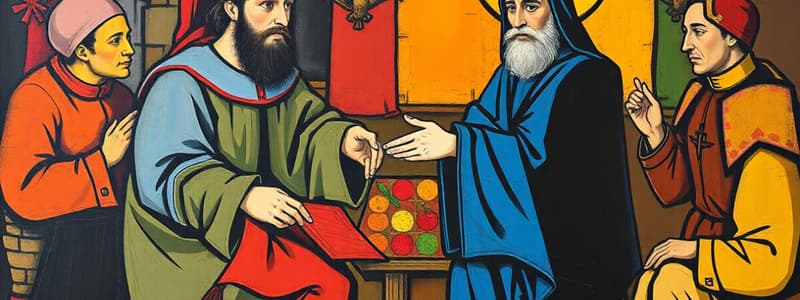Podcast
Questions and Answers
What action did Pope Pius IV take against bishops living in Rome?
What action did Pope Pius IV take against bishops living in Rome?
- He encouraged them to expand their residences.
- He restricted their powers significantly.
- He forced them to relocate to their areas of responsibility. (correct)
- He allowed them to stay indefinitely.
Which religious order focused on missionary work among the poor?
Which religious order focused on missionary work among the poor?
- Franciscans
- Capuchins (correct)
- Benedictines
- Ursulines
What was one of the main purposes of the catechisms produced by the RCC?
What was one of the main purposes of the catechisms produced by the RCC?
- To increase taxation among the clergy.
- To promote literacy in the vernacular.
- To reaffirm Church doctrines and practices. (correct)
- To replace the Bible as the primary religious text.
How did the Reformation impact the role of women according to Protestants?
How did the Reformation impact the role of women according to Protestants?
Which cultural development greatly aided the spread of Reformation ideas?
Which cultural development greatly aided the spread of Reformation ideas?
What stance did the RCC take on women in religious leadership roles?
What stance did the RCC take on women in religious leadership roles?
What was the role of popular festivals during the Reformation?
What was the role of popular festivals during the Reformation?
What educational initiative was promoted by the RCC during the Reformation?
What educational initiative was promoted by the RCC during the Reformation?
Flashcards
Catholic Reformation
Catholic Reformation
A Catholic reform movement that addressed social issues, emphasized religious education, and strengthened the authority of the Church.
Capuchins
Capuchins
A new order of Catholic monks known for their austere lifestyle and work with the sick.
Ursulines
Ursulines
A group of Catholic nuns focusing on education for girls.
Vincent de Paul
Vincent de Paul
Signup and view all the flashcards
Catechism
Catechism
Signup and view all the flashcards
Culture During the Two Reformations
Culture During the Two Reformations
Signup and view all the flashcards
The Role of Women During the Reformation
The Role of Women During the Reformation
Signup and view all the flashcards
Lay Education and Reading During the Reformation
Lay Education and Reading During the Reformation
Signup and view all the flashcards
Study Notes
The Reformation and Counter-Reformation
- The Protestant Reformation challenged the authority of the Catholic Church in the 16th century.
- Key figures like Martin Luther and John Calvin led the movement, advocating for religious reforms.
- The Reformation led to the establishment of new Protestant denominations.
- The Counter-Reformation was the Catholic Church's response to the Reformation.
- The Council of Trent (1545-1563) addressed issues within the Catholic Church.
- The Council reaffirmed Catholic doctrine and practices, taking steps to address abuses.
- Counter-Reformation measures included establishing seminaries for clergy training and the suppression of some popular religious practices.
- The emphasis on literacy and education increased among both Protestants and Catholics during this period.
The Role of Women
- Protestant reformers held different views on women's roles in the church and society than the Catholic Church.
- Protestants generally emphasized women's roles within the family and household.
- Catholic views of women often involved their prominence in religious orders.
- Some women played prominent roles as leaders in the Protestant Reformation, but this was not the norm.
- Many women demonstrated their faith through participating in religious activities and educational pursuits.
Printing Press and Cultural Impact
- The printing press, a major invention, revolutionized communication and spread religious ideas.
- Printed materials, like Luther's works, reached a wider audience.
- Print culture played a significant role in the spread of the Reformation.
- Printing allowed the translation of religious texts into vernacular languages.
- This increase in literacy impacted the social and political spheres.
Popular Religion and Rituals
- Popular religious practices and festivals existed alongside formal religious structures.
- The Catholic Church aimed to incorporate popular practices or suppress them.
- Protestants, sometimes, believed certain popular customs contradicted their teachings.
- There was conflict between religious authorities, local communities, and popular beliefs.
Education and Literacy
- The Reformation and Counter-Reformation fostered educational development.
- Increased literacy rates occurred both among Protestants and Catholics.
- Improvements in education and the spread of literacy contributed to the changing social and religious landscape.
- More people could read and interpret the Bible, leading to differing interpretations of religious beliefs.
Studying That Suits You
Use AI to generate personalized quizzes and flashcards to suit your learning preferences.
Related Documents
Description
This quiz explores the Protestant Reformation and the Catholic Church's Counter-Reformation in the 16th century. It covers key figures like Martin Luther and John Calvin, the establishment of new denominations, and the Council of Trent's reforms. Additionally, it highlights the roles of women and the emphasis on literacy during this transformative period in history.

